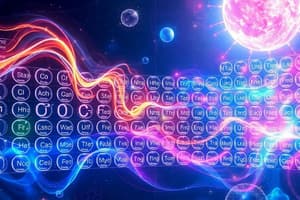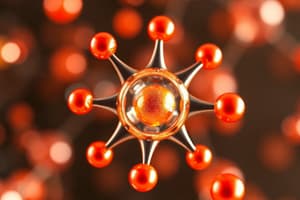Podcast
Questions and Answers
What is the primary basis for the arrangement of elements in the periodic table?
What is the primary basis for the arrangement of elements in the periodic table?
- Increasing atomic number (correct)
- Increasing atomic mass
- Valence electron configuration
- Chemical reactivity
Where are metalloids typically located on the periodic table?
Where are metalloids typically located on the periodic table?
- In the central block
- At the bottom rows only
- In the far left column
- Along a stair-step line (correct)
Which statement accurately describes isotopes?
Which statement accurately describes isotopes?
- Isotopes of an element all have the same mass number
- Isotopes differ in the number of neutrons, affecting atomic mass (correct)
- All isotopes are radioactive
- Isotopes have the same number of neutrons but different protons
In terms of atomic theory, which statement is correct?
In terms of atomic theory, which statement is correct?
How is atomic mass different from mass number?
How is atomic mass different from mass number?
Which of the following statements about transition metals is true?
Which of the following statements about transition metals is true?
What is true about radioactive isotopes?
What is true about radioactive isotopes?
Which theory does modern atomic theory build upon while introducing additional concepts?
Which theory does modern atomic theory build upon while introducing additional concepts?
Flashcards
Atomic Number
Atomic Number
The number of protons in the nucleus of an atom, determining its atomic identity.
Groups (Families) in Periodic Table
Groups (Families) in Periodic Table
Elements with similar chemical properties are grouped vertically in the periodic table, sharing similar valence electron configurations.
Isotopes
Isotopes
Atoms of the same element with the same number of protons but differing numbers of neutrons. They have the same chemical properties but different atomic masses.
Mass Number
Mass Number
Signup and view all the flashcards
Atomic Mass
Atomic Mass
Signup and view all the flashcards
Dalton's Atomic Theory
Dalton's Atomic Theory
Signup and view all the flashcards
Modern Atomic Theory
Modern Atomic Theory
Signup and view all the flashcards
Electron Shells
Electron Shells
Signup and view all the flashcards
Study Notes
Periodic Table Setup and Organization
- The periodic table arranges elements based on increasing atomic number, reflecting the number of protons in the atom's nucleus.
- Elements with similar chemical properties are grouped vertically into columns (groups or families).
- Elements are also organized horizontally into rows (periods).
- Elements within the same group share similar valence electron configurations, leading to common chemical reactions and properties.
- Metals are typically located on the left side and middle of the table, while nonmetals are predominantly on the right side.
- Transition metals are found in the central block.
- Metalloids exhibit properties intermediate between metals and nonmetals, located along a stair-step line.
- The table provides a visual representation of electron relationships among elements, aiding in predicting chemical behavior.
Isotopes
- Isotopes are atoms of the same element with the same number of protons but a different number of neutrons.
- The number of protons defines the element's identity.
- The difference in neutrons causes variations in atomic mass.
- Isotopic notation shows the element symbol, mass number (protons + neutrons), and sometimes atomic number (protons).
- Isotopes can be stable or unstable (radioactive).
- Radioactive isotopes decay over time, emitting radiation.
- The relative abundance of isotopes is crucial in calculating the average atomic mass of an element.
Atomic Theory
- Dalton's atomic theory proposed that all matter is composed of indivisible atoms of varying mass and properties.
- Atoms of the same element are identical and have the same mass.
- Atoms of different elements combine in simple whole number ratios to form chemical compounds.
- Atoms are neither created nor destroyed during chemical reactions.
- Modern atomic theory builds upon Dalton's concept, acknowledging the subatomic constituents: protons, neutrons, and electrons.
- Atoms are mostly empty space with a dense nucleus containing protons and neutrons.
- Electrons orbit the nucleus in specific energy levels.
- Quantum mechanics describes the behavior of electrons and other subatomic particles.
Atomic Mass and Mass Number
- Atomic mass is the average mass of all isotopes of an element, weighted by their relative abundance.
- It is measured in atomic mass units (amu) or daltons (Da).
- Mass number is the sum of the protons and neutrons in an atom's nucleus.
- It is a whole number and describes the mass of a specific isotope.
- The atomic mass of an element is not a whole number due to the weighted average of various isotopes' abundances.
- Atomic mass is often rounded to more convenient values.
Studying That Suits You
Use AI to generate personalized quizzes and flashcards to suit your learning preferences.



